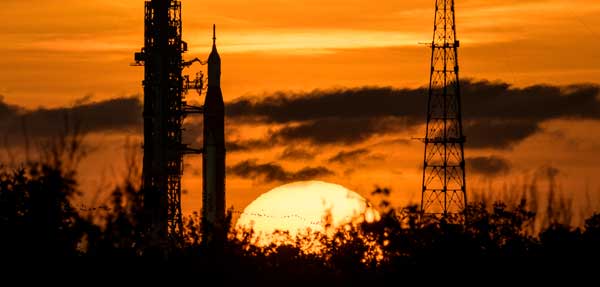
Northrop Grumman launched a resupply ship to the International Space Station (ISS) early Monday morning, kicking off a busy nine-day period that — if all goes well — will see NASA send an automated Orion crew vehicle to orbit the moon.
A Northrop Grumman Antares rocket lifted off with the Cygnus NG-18 cargo ship S.S. Sally Ride at 5:32:42 a.m. EST on Monday. NASA and Northrop Grumman said the spacecraft will be able to complete its mission to ISS despite one of its two solar panels failing to deploy.
Cygnus Secondary Payloads
| Payload | Organization | Purpose |
|---|---|---|
| PearlAfricaSat-1 | Uganda | Earth observation |
| SeaLion | Old Dominion University – U.S. Coast Guard Academy | Communications |
| TAKA | Kyushu Institute of Technology | Earth observation |
| UtProSat-1 | Virginia Tech | Communications |
| ZIMSAT-1 | Zimbabwe | Earth observation |
Cygnus carried five secondary payloads into orbit. SeaLion and UtProSat-1 were to be deployed from the Antares rocket into very low Earth orbits. The other three satellites will be deployed from the space station.
Back to the Moon
The Antares launch was one of eight orbital flights scheduled through Oct. 15. The most noteworthy one will be NASA’s maiden launch of the Space Launch System (SLS) scheduled for next Monday, Nov. 14. SLS will send an Orion spacecraft on a 25-day mission to the moon in a precursor to a crewed flight to the moon scheduled for 2024. A 69-minute launch window will begin at 12:07 a.m. EST (05:07 UTC).
The launch is part of NASA’s Artemis program to send astronauts to the surface of the moon for the first time since the Apollo 17 mission in December 1972. The landing is scheduled for no earlier than 2025.
Artemis I will carry 10 secondary payloads that will take advantage of the mission’s lunar trajectory to perform a series of tasks, including searching for water ice below the moon’s surface.
Artemis I Secondary Payloads
| Payload | Organization | Purpose |
|---|---|---|
| ArgoMoon | Italian Space Agency | Technology demonstration |
| BioSentinel | NASA | Astrobiology |
| CuSP | NASA | Space weather |
| EQUULEUS | University of Tokyo | Earth observation |
| LunaH-Map | NASA | Lunar orbiter |
| Lunar IceCube | NASA | Lunar orbiter |
| LunIR | Lockheed Martin | Technology demonstration |
| Near-Earth Asteroid Scout | NASA | Technology demonstration |
| OMOTENASHI | Japan Aerospace Exploration Agency | Lunar lander |
| Team Miles | Fluid & Reason | Technology demonstration |
The Japan Aerospace Exploration Agency’s is sending the Outstanding MOon exploration TEchnologies demonstrated by NAno Semi-Hard Impactor (OMOTENASHI) to the moon. The 6U CubeSat is designed to test low-cost ways of landing and exploring the lunar surface.
There have been concerns about whether all the secondary payloads will function given how long they have been installed in SLS. NASA officials said they have been able to recharge the batteries of only six of the 10 spacecraft.
Weather Satellite & Reentry Experiment
An United Launch Alliance (ULA) Atlas V booster is set to launch America’s newest weather satellite, Joint Polar Satellite System-2 (JPSS-2), on Thursday, Nov. 10 from Vandenberg Space Force Base in California. Launch of the NOAA satellite is scheduled for 1:25 a.m. PST (4:25 a.m. EST/09:25 UTC).
Atlas V will carry a secondary payload, the Low-Earth Orbit Flight Test of an Inflatable Decelerator (LOFTID), in a test of an inflatable heat shield that could one day land large payloads on Mars and other worlds.
Orbital Launches
Nov. 7 – 15 2022
| Date | Launcher – Organization | Payload – Organization | Purpose | Launch Site |
|---|---|---|---|---|
| Nov. 7 | Antares – Northrop Grumman | Cygnus – Northrop Grumman | ISS resupply, rideshare | Wallops |
| Nov. 10 | Atlas V – ULA | JPSS-2, LOFTID – NOAA, NASA | Meteorology, technology demonstration | Vandenberg |
| Nov. 11 | Long March 6A – CASC* | Y2 – CASC* | TBA | Taiyuan |
| Nov. 12 | Long March 7 – CASC* | Tianzhou-5 – CMSA+ | Station resupply, rideshare | Wenchang |
| Nov. 12 | Falcon 9 – SpaceX | Galaxy 31, 32 – Intelsat | GEO Comsats | Cape Canaveral |
| Nov. 14 | Space Launch System – NASA | Orion – NASA | Lunar flight test, rideshare | Kennedy |
| Nov. 15 | Long March 4C – CASC* | Yaogan 34-03 (?) – CAS^ | Earth observation | Jiuquan |
| Nov. 15 | Ceres – Galactic Energy | Gaofen-03D 08, 51-54 – Chang Guang Satellite Technology | Earth observation | Jiuquan |
+ China Manned Space Agency
^ Chinese Academy of Sciences
Source: Wikipedia
China is scheduled to launch the Tianzhou-5 resupply ship to the Tiangong space station on Saturday, Nov. 12. The mission will carry at least six satellites for deployment into low Earth orbit.
Tianzhou-5 Secondary Payloads
| Payload | Organization | Purpose |
|---|---|---|
| CAS-10 (XW-4) | CAMSAT | Amateur radio |
| Macao Science 1 | Macau University of Science and Technology | South Atlantic Anomaly observation |
| Zhixing-3A | Beijing Smart Satellite Technology | Earth observation |
| Lianli | Dalian University of Technology | TBA |
| Shengxi Jishu Yanzheng | TBA | Technology demonstration |
| Gaoxin-1 | TBA | TBA |
The Tianzhou-5 launch will be one of four Chinese launches scheduled through Tuesday, Nov. 15. Payloads will include six Earth observation satellites.
SpaceX will also launch the Galaxy 31 and Galaxy 32 geosynchronous communications satellites for Intelsat no earlier than Saturday, Nov. 12. The company said the launch has been pushed back from Tuesday, Nov. 8, due to Tropical Storm Nicole.

